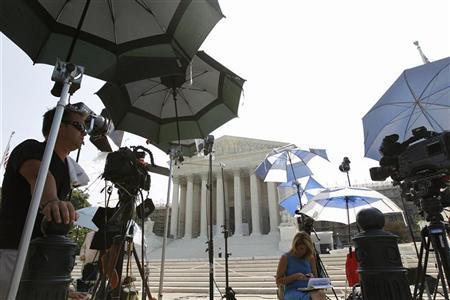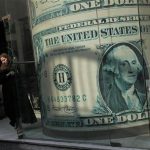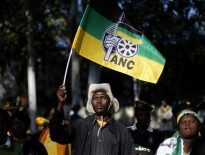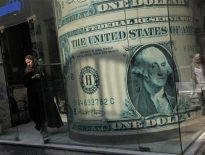(Reuters) – During a break from the crush of last-minute opinion-writing, U.S. Supreme Court Justice Ruth Bader Ginsburg told an audience of 1,000 people last week at a Washington legal convention: “It is flood season at the court.”

For the rest of the country it has been more like a drought, a stretch of weeks without any word in the most closely watched cases – the blockbuster challenges to President Barack Obama’s healthcare plan and Arizona’s crackdown on illegal immigration.
The immigration case was heard on April 25, the last day of oral arguments, the healthcare case over the course of three days a month before that. It seems the justices are going for maximum drama as they push these cliffhangers to the end of June. What’s more likely, as seasoned court-watchers know, is that justices are still ironing out the final details of resolutions to the most complex questions they have faced in decades.
Of the 60 signed rulings that have been handed down in the cases heard during arguments in the October-to-April term, many were reached by a unanimous or nearly unanimous vote. In the final days, Ginsburg told the group, “the sharp disagreement rate will go up.” She was speaking about what generally happens at the court – although it might have seemed she was letting slip a clue about the current deliberations.
Including the immigration and healthcare disputes, a total of nine individual cases await resolution. Also pending are challenges to a U.S. law that makes it a crime to lie about military honors and to life imprisonment for juvenile offenders.
The court does not reveal when decisions will be announced and has said only that it will be in session on Monday. Decisions are typically released the last Thursday in June, too, although there are whispers that a third decision day, possibly Wednesday, could be added to next week’s schedule. It would be a surprise – and only mean intractable differences behind the scenes – if the nine justices were still working into July.
That, of course, would make packing up for summer a little more rushed, as the justices are headed for their usual round of speaking engagements in enviable locales. Chief Justice John Roberts, for example, is scheduled to teach a series of classes starting July 2 in Malta. Justice Antonin Scalia will be a “distinguished visiting jurist” at a program in Innsbruck, Austria, that also starts in early July. Ginsburg is scheduled to teach in Venice, Italy, and Vienna later in the month.
THE RITES OF JUNE
Within the marble walls, the juridical rites of June are full of tension, but also toasts. The justices hold their annual service award ceremony for staff. They attend lunches hosted by sets of law clerks from other chambers. If tradition holds, the justices will raise a glass of wine for their colleagues with June birthdays: Justice Clarence Thomas turns 64 on Saturday, and Justice Sonia Sotomayor will be celebrating her 58th when the court convenes on Monday.
The term is capped off by a party – attended only by the justices and their full-time employees – at which law clerks parody the justices in musical skits.
“It is a simultaneously exciting and exhausting time,” said Kannon Shanmugam, a former law clerk to Scalia and now a partner at Williams & Connolly in Washington, D.C. “There’s a good chance that with healthcare all the chambers are engaged in some way … and at full capacity.”
There are other routines. Votes on the judgment in a particular case are taken the week of its oral arguments. Chief Roberts or, if he is not in the majority, the senior justice on the winning side, assigns the majority opinion. The senior justice in dissent assigns for that side. Any justice may write a concurring statement to explain a vote.
For the healthcare cases, preliminary votes and assignments occurred in the justices’ private conference on March 30, the Friday after the oral arguments. Since then, the justices have been drafting opinions in that controversy and others. All nine are kept in a conversation of sorts as messengers hand-deliver drafts to individual chambers. (These days, law clerks also distribute copies by email.)
By the time decision-making began stretching into June, the late Justice William Rehnquist, who served as chief justice from 1986-2005, tended to want simply to get it all over with. “If this were November rather than June,” he once wrote to a colleague, “I would prepare a masterfully crafted dissenting opinion … Since it is June, however, I join” the majority opinion.
One year, when the justices were tangling over a handgun-control law until the final days of the month, Rehnquist kept his travel plans. When that ruling, Printz v. United States, was announced on Friday, June 27, 1997, Rehnquist was already on his way to Rome.
VELVET DRAPES, BLACK ROBES
The justices always begin releasing their opinions at 10 a.m. sharp. To the “Oyez, oyez” chant of Marshal Pamela Talkin, the justices emerge in their black robes from behind crimson velvet drapes and ascend the bench. As decisions are ceremoniously announced from the bench, they are posted to the Supreme Court’s website (supremecourt.gov) and distributed to reporters waiting in the pressroom on the ground floor of the columned court building.
Justices’ spouses often take special guest seats near the bench to watch the drama. Some lawyers associated with the healthcare case have been regulars this month in the section reserved for lawyers. From the center black leather chair, Roberts introduces each case by number and name, and then declares who authored it for the majority. That justice then begins to read excerpts of the opinion.
A dissenting justice will sometimes take the unusual step of reading portions of his or her contrary statement from the tall mahogany bench, too. In January 2010, Justice John Paul Stevens voiced an impassioned dissent in the campaign finance case of Citizens United v. Federal Election Commission. Stevens, then about to turn 90, retired at the end of that term.
Often retired justices show up in the courtroom for big June days. Last Monday, Justice Sandra Day O’Connor was there in a prime guest seat. Two weeks ago, she said she did not know if she would be in Washington on the day the healthcare ruling was released.
If O’Connor, who stepped down in January 2006, knows what her erstwhile colleagues are deciding on that case, she isn’t talking.
When asked recently by a reporter about the dispute over the law signed by Obama in March 2010, she quickly protested, “I haven’t even read the statute.”
Does she have a suspicion on how the court might rule?
“I haven’t a clue.”
(Reporting By Joan Biskupic; Editing by Amy Stevens, Howard Goller and Bill Trott)





